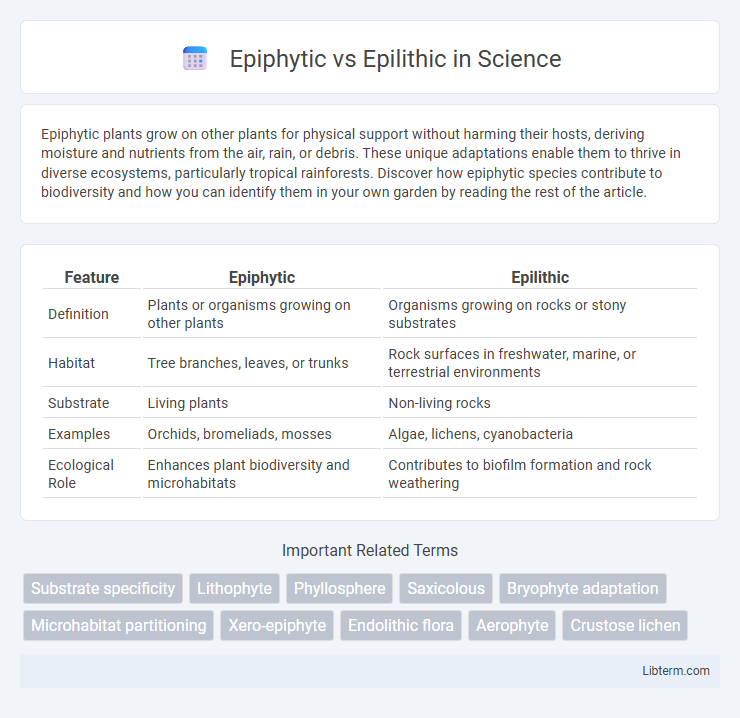Epiphytic plants grow on other plants for physical support without harming their hosts, deriving moisture and nutrients from the air, rain, or debris. These unique adaptations enable them to thrive in diverse ecosystems, particularly tropical rainforests. Discover how epiphytic species contribute to biodiversity and how you can identify them in your own garden by reading the rest of the article.
Table of Comparison
| Feature | Epiphytic | Epilithic |
|---|---|---|
| Definition | Plants or organisms growing on other plants | Organisms growing on rocks or stony substrates |
| Habitat | Tree branches, leaves, or trunks | Rock surfaces in freshwater, marine, or terrestrial environments |
| Substrate | Living plants | Non-living rocks |
| Examples | Orchids, bromeliads, mosses | Algae, lichens, cyanobacteria |
| Ecological Role | Enhances plant biodiversity and microhabitats | Contributes to biofilm formation and rock weathering |
Understanding Epiphytic and Epilithic Growth Habits
Epiphytic plants grow on other plants, typically trees, absorbing moisture and nutrients from the air, rain, and debris around them without harming their host, making them crucial for biodiversity in forest canopies. Epilithic organisms, such as certain algae and lichens, colonize rock surfaces, adapting to harsh, nutrient-poor environments by anchoring firmly and extracting nutrients from rainwater and atmospheric sources. Understanding these distinct growth habits highlights their ecological roles, with epiphytes contributing to habitat complexity and epilithics playing essential roles in primary succession and soil formation.
Key Differences Between Epiphytic and Epilithic Organisms
Epiphytic organisms grow on other plants for physical support without harming the host, commonly seen in orchids and mosses, while epilithic organisms attach to rocks or other non-living surfaces, such as algae and lichens. Epiphytes obtain moisture and nutrients primarily from the air and rain, whereas epiliths derive nutrients from the mineral surface or surrounding water. These fundamental differences impact their ecological roles and adaptive strategies in various environments.
Example Species of Epiphytes and Epiliths
Epiphytic species such as orchids (e.g., Phalaenopsis) and bromeliads (e.g., Tillandsia) grow on other plants without harming them, deriving moisture and nutrients from the air and rain. Epilithic species like lichens (e.g., Xanthoria parietina) and certain algae (e.g., Trentepohlia) colonize rock surfaces, adapting to nutrient-poor substrates by extracting minerals directly from the rock or surrounding environment. These distinct growth strategies highlight the ecological specialization of epiphytes and epiliths in diverse habitats.
Adaptations for Epiphytic and Epilithic Life
Epiphytic plants exhibit specialized adaptations such as velamen roots for moisture absorption, thick waxy leaves to minimize water loss, and mutualistic relationships with fungi for enhanced nutrient uptake. Epilithic organisms adapt by developing strong adhesion structures, slow growth rates to conserve resources, and the ability to tolerate extreme fluctuations in temperature and moisture on rock surfaces. Both lifestyles showcase evolutionary strategies optimized for nutrient-poor and variable habitats, with epiphytes thriving above ground on other plants and epiliths colonizing bare rock substrates.
Ecological Roles in Various Ecosystems
Epiphytic organisms, such as many orchids and bromeliads, grow on living plants and play a vital role in forest ecosystems by providing habitat and food for insects, birds, and other wildlife, while enhancing nutrient cycling in the canopy. Epilithic species, including certain algae and lichens, colonize rock surfaces in aquatic and terrestrial ecosystems, contributing to soil formation and stabilizing substrates against erosion. Both epiphytic and epilithic communities support biodiversity and influence ecosystem functions by modifying microhabitats and facilitating nutrient exchange in their respective environments.
Nutrient Acquisition Strategies
Epiphytic plants acquire nutrients primarily from the air, rain, and debris accumulating around their roots, often developing specialized structures such as velamen to enhance water and nutrient absorption. Epilithic organisms, such as certain algae and lichens, extract nutrients directly from the mineral surfaces they colonize by secreting organic acids that solubilize minerals. These contrasting nutrient acquisition strategies reflect adaptations to their distinct substrates: epiphytes rely on external organic matter and atmospheric inputs, while epiliths depend on chemical weathering of inorganic rock surfaces.
Environmental Conditions and Distribution
Epiphytic plants thrive in humid, tropical forest canopies where they attach to trees and absorb moisture from the air, promoting widespread distribution in rainforests globally. Epilithic organisms colonize rock surfaces in exposed environments such as alpine, coastal, and desert regions, adapting to nutrient-poor substrates and fluctuating moisture levels. The distinct environmental conditions of high humidity versus exposed, nutrient-scarce habitats drive the contrasting distribution patterns of epiphytic and epilithic species.
Importance for Biodiversity and Habitat Structure
Epiphytic and epilithic organisms both play crucial roles in enhancing biodiversity and structuring habitats by providing unique microenvironments that support diverse communities of plants, fungi, and microorganisms. Epiphytes, growing on other plants, increase vertical habitat complexity and offer resources such as moisture and nutrients, fostering increased species richness in forest canopies and other ecosystems. Epilithic species, colonizing rock surfaces, contribute to soil formation and nutrient cycling, supporting pioneer communities and stabilizing habitats essential for ecological succession.
Human Impacts and Conservation Concerns
Epiphytic and epilithic organisms face distinct human impacts that threaten their survival, with habitat destruction and pollution being primary concerns for both groups. Deforestation and urbanization particularly disrupt epiphytic plants by reducing their arboreal hosts, while epilithic communities on rocks suffer from water contamination and physical disturbances such as rock quarrying. Conservation efforts must prioritize habitat preservation, pollution control, and restoration initiatives to maintain the ecological roles and biodiversity of both epiphytic and epilithic species.
Future Research Directions
Future research in epiphytic and epilithic communities should prioritize advanced molecular techniques to unravel species interactions and adaptation mechanisms on plant and rock substrates. Investigating climate change impacts on these communities' distribution can provide critical insights into ecosystem resilience and biodiversity shifts. Integrating remote sensing technology with ecological modeling will enhance monitoring and predictive accuracy for epiphytic and epilithic habitat dynamics.
Epiphytic Infographic

 libterm.com
libterm.com